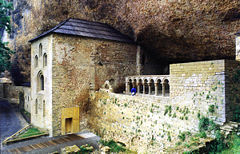
San Juan de la Peña
Encyclopedia


Santa Cruz de la Serós
Santa Cruz de la Serós is a village in the province of Huesca, Aragon, Spain. Located 88 kilometers from the city of Huesca, it is located at a hill side on the way to the Monastery of San Juan de la Peña.-Monuments:...
, at the south-west of Jaca
Jaca
Jaca is a city of northeastern Spain near the border with France, in the midst of the Pyrenees in the province of Huesca...
, in the province of Huesca, Spain
Spain
Spain , officially the Kingdom of Spain languages]] under the European Charter for Regional or Minority Languages. In each of these, Spain's official name is as follows:;;;;;;), is a country and member state of the European Union located in southwestern Europe on the Iberian Peninsula...
. It was one of the most important monasteries in Aragon
Aragon
Aragon is a modern autonomous community in Spain, coextensive with the medieval Kingdom of Aragon. Located in northeastern Spain, the Aragonese autonomous community comprises three provinces : Huesca, Zaragoza, and Teruel. Its capital is Zaragoza...
in the Middle Ages
Middle Ages
The Middle Ages is a periodization of European history from the 5th century to the 15th century. The Middle Ages follows the fall of the Western Roman Empire in 476 and precedes the Early Modern Era. It is the middle period of a three-period division of Western history: Classic, Medieval and Modern...
. Its two-level church is partially carved in the stone of the great cliff that overhangs the foundation. San Juan de la Peña means "Saint John of the Rock".
The lower church includes some mozarabic architectural surviving elements, although most of the parts of the monastery (including the impressive cloister, under the great rock) are Romanesque
Romanesque architecture
Romanesque architecture is an architectural style of Medieval Europe characterised by semi-circular arches. There is no consensus for the beginning date of the Romanesque architecture, with proposals ranging from the 6th to the 10th century. It developed in the 12th century into the Gothic style,...
. After the fire of 1675, a new monastery was built. The old monastery (built in 920) was declared National Monument on 13 July 1889, and the new monastery in 1923. In the 11th century the monastery became part of the Benedictine Order and was the first monastery in Spain to use the Latin Mass.
The cloister, built ca. 1190, contains a series of capitals
Capital (architecture)
In architecture the capital forms the topmost member of a column . It mediates between the column and the load thrusting down upon it, broadening the area of the column's supporting surface...
with Biblical scenes that originally were arranged in chronological sequence, a design found elsewhere in the region.
The monastery is built beneath a huge rock sometimes associated with the legendary "Monte Pano". The second floor contains a royal pantheon of kings of Aragon and Navarre. The present room, with its marbles and stucco medallions recalling historic battles, is mainly a design built during the administration of Charles III of Spain
Charles III of Spain
Charles III was the King of Spain and the Spanish Indies from 1759 to 1788. He was the eldest son of Philip V of Spain and his second wife, the Princess Elisabeth Farnese...
in 1770. It contains the resting places of the following kings of Aragón: Ramiro I
Ramiro I of Aragon
Ramiro I was de facto the first King of Aragon from 1035 until his death. Apparently born before 1007, he was the illegitimate son of Sancho III of Navarre by his mistress Sancha de Aybar...
, Sancho Ramírez, and Peter I of Aragon and Navarre
Peter I of Aragon and Navarre
Peter I was the King of Aragon and Navarre for a decade from 1094 until his death. He was the son and successor of Sancho V Ramírez by his first wife, Isabella of Urgell. He was named in honour of Saint Peter, because of his father's special devotion to the Holy See, to which he had made his...
Legend said that the chalice of the Last Supper
Last Supper
The Last Supper is the final meal that, according to Christian belief, Jesus shared with his Twelve Apostles in Jerusalem before his crucifixion. The Last Supper provides the scriptural basis for the Eucharist, also known as "communion" or "the Lord's Supper".The First Epistle to the Corinthians is...
(Holy Grail
Holy Grail
The Holy Grail is a sacred object figuring in literature and certain Christian traditions, most often identified with the dish, plate, or cup used by Jesus at the Last Supper and said to possess miraculous powers...
) was sent to the monastery for protection and prevention from being captured by the Muslim invaders of the Iberian Peninsula.
The monastery is the namesake of the Chronicle of San Juan de la Peña
Chronicle of San Juan de la Peña
The Chronicle of San Juan de la Peña is an Aragonese chronicle written in Latin around 1370 in the monastery of San Juan de la Peña at the behest of Peter IV of Aragon...
, which was partially researched and composed there.

